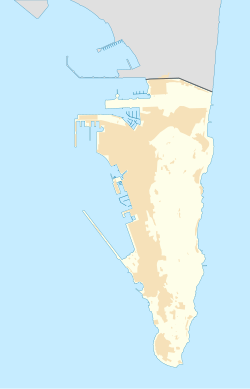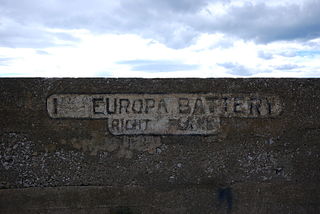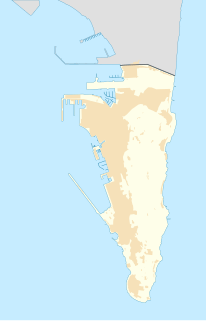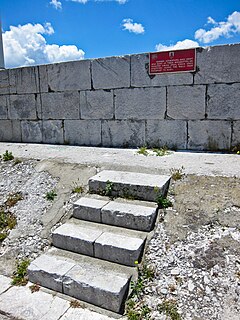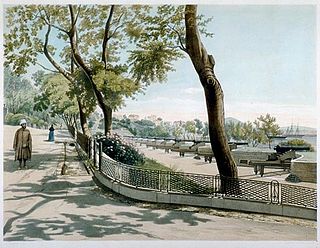| Retrenched Barracks | |
|---|---|
| Part of Fortifications of Gibraltar | |
| Windmill Hill in Gibraltar | |
| Coordinates | 36°07′06″N5°20′41″W / 36.118433°N 5.344812°W Coordinates: 36°07′06″N5°20′41″W / 36.118433°N 5.344812°W |
| Type | Barracks |
| Site information | |
| Owner | Government of Gibraltar |
| Open to the public | No |
| Condition | Converted into facilities for clubs and associations |
| Site history | |
| Built | 1841 |
| Built by | UK Ministry of Defence |
| Materials | Limestone |
The Retrenched Barracks was a fortified barracks located at Windmill Hill in the British Overseas Territory of Gibraltar. It stands to the north of the southern tip of Gibraltar, Europa Point, which was long felt to be potentially vulnerable to a surprise attack from the sea and was heavily fortified with gun batteries, perimeter walls and scarped cliffs.

A barracks is a building or group of buildings built to house soldiers. The English word comes via French from an old Catalan word "barraca" (hut), originally referring to temporary shelters or huts for various people and animals, but today barracks are usually permanent buildings for military accommodation. The word may apply to separate housing blocks or to complete complexes, and the plural form often refers to a single structure and may be singular in construction.

The British Overseas Territories (BOTs) or United Kingdom Overseas Territories (UKOTs) are 14 territories under the jurisdiction and sovereignty of the United Kingdom. They are remnants of the British Empire that have not been granted independence or have voted to remain British territories. These territories do not form part of the United Kingdom and, with the exception of Gibraltar, are not part of the European Union. Most of the permanently inhabited territories are internally self-governing, with the UK retaining responsibility for defence and foreign relations. Three are inhabited only by a transitory population of military or scientific personnel. They all share the British monarch as head of state.

Gibraltar is a British Overseas Territory located at the southern tip of the Iberian Peninsula. It has an area of 6.7 km2 (2.6 sq mi) and is bordered to the north by Spain. The landscape is dominated by the Rock of Gibraltar at the foot of which is a densely populated town area, home to over 30,000 people, primarily Gibraltarians.
In 1841, Major General Sir John Thomas Jones recommended in a report on Gibraltar's fortifications that a line of retrenchments should be built at the head of Windmill Hill to block an invader's line of advance from Europa Point up the peninsula. The hill provided a formidable defensive position which enfiladed the road from Europa; as Jones put it, "Two hundred men on Windmill Hill and Europa Pass ought to hold as many thousands at bay." [1]
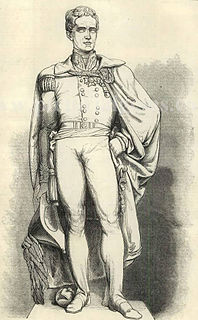
Major General Sir John Thomas Jones, 1st Baronet was a British officer in the Royal Engineers who played a leading engineering role in a number of European campaigns of the early nineteenth century. Jones was regarded by Wellington and asked to advise on fortifications including the modernisation of the defences in Gibraltar. He was also notable as an English amateur cricketer who made six first-class appearances.
The barracks, which Jones himself designed, was originally intended to be accompanied by a citadel which would serve as a central rallying point. This, however, proved too expensive and was never built. In its final form, the barracks consisted of two demi-bastions, joined by a curtain wall behind which the main barracks block is located. Four gun embrasures were built on the right demi-bastion and one on the left flank, providing a defence from naval bombardment, while the top of the wall is loopholed to accommodate rifles along almost all of its length. The barracks block is constructed of white limestone quarried locally and stands two stories high with a basement. Its external elevation has a bold and simple design, with each bay having one arched window on the ground floor and two plain windows above on the first floor. [2]

A citadel is the core fortified area of a town or city. It may be a castle, fortress, or fortified center. The term is a diminutive of "city" and thus means "little city", so called because it is a smaller part of the city of which it is the defensive core. Ancient Sparta had a citadel as did many other Greek cities and towns.

A curtain wall is a defensive wall between two towers (bastions) of a castle, fortress, or town.

Limestone is a carbonate sedimentary rock that is often composed of the skeletal fragments of marine organisms such as coral, foraminifera, and molluscs. Its major materials are the minerals calcite and aragonite, which are different crystal forms of calcium carbonate (CaCO3). A closely related rock is dolomite, which contains a high percentage of the mineral dolomite, CaMg(CO3)2. In fact, in old USGS publications, dolomite was referred to as magnesian limestone, a term now reserved for magnesium-deficient dolomites or magnesium-rich limestones.
